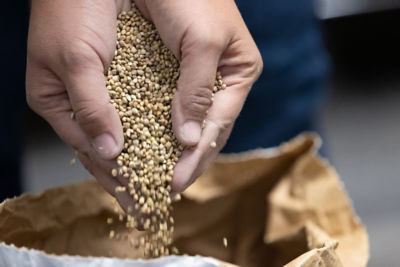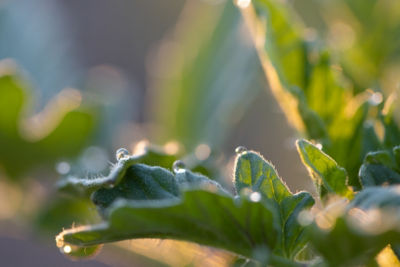Click here to download a PDF version of this spotlight.
» The changing costs and availability of labor are increasing the desire for automated harvest of broccoli.
» Uniformity of heads and placement in the canopy can affect head recovery efficiency with automated harvest systems.
» Varietal attributes and cultural practices impact the traits required for successful automated harvesting.
Harvesting Broccoli
The cost of harvesting broccoli is one of the largest expense factors in the production of broccoli.1 The cost of labor makes up a large portion of those expenses. With the availability of labor decreasing and the costs of labor increasing, growers are looking for alternative means of harvesting. The idea of automated broccoli harvest systems has been around for many years, but changes in the labor picture have renewed grower interest in this idea.
The current state of mechanization in broccoli harvest is the use of harvest-aids. With these systems, workers manually cut the heads off the plants and place them on the conveyor belt of the harvest-aid. The harvest-aid helps in sorting and packing the crop in the field, but the harvest process is still labor intensive.1 With the hand-harvesting of broccoli, the crop is usually harvested several times, allowing primary and secondary heads to reach their target size before harvest.
In an automated harvest system, the machinery removes the heads from the broccoli plants. With most of the systems developed so far, this involves a single destructive harvest when the number of marketable heads is at its peak. Two types of automated harvest systems are being investigated, those that are strictly mechanical and those that use computer and robotic components. Strictly mechanical systems are similar to a corn harvester (combine) where the combine head is set to a specific height. Mechanical action cuts the broccoli head and separates the head from unwanted plant debris. With a robotic system, a camera connected to a computer is used to locate and evaluate the head on a plant. If the identified head is acceptable, it is cut at an appropriate height. Robotic systems have the potential to be more efficient, maximizing the recovery rate. They are also more complex and likely to be more expensive to purchase and maintain.
With either mechanical or robotic systems, there is a critical need for uniformity of the crop regarding head size and height within the canopy. Several factors affect the uniformity of a broccoli planting. These include planting density, stand uniformity, planting depth, soil type, soil fertility, soil moisture (amount and uniformity), light (availability and uniformity), insects and diseases, and host genetics (varietal traits).2
Planting Density
The density of a broccoli planting affects the size and number of marketable heads produced. Increasing the number of plants per acre increases the number of marketable heads, up to a point. If the populations get too high, plant to plant competition for resources (light, water, nutrients) reduces head size and quality and increases variation in head size. Different plant spacing systems are used in different regions of the U.S., depending on the length of the season, environmental conditions, and the harvested product. Broccoli production in California generally uses high plant populations (40,000 to 60,000 plants per acre) to produce smaller heads that are bunched (two to four heads per bunch) or sold as small head crown cut (shorter stem cuts).3 However, the practice of harvesting for florets is becoming more common, and lower planting densities (a row spacing of 8-inch rather than 6-inch) are preferred for this system. In other areas of the U.S. with shorter growing seasons or less favorable growing conditions, lower plant populations are used (20,000 to 30,000 plants per acre) to produce larger, single crown cut heads.4
Planting densities that maximize uniformity are better adapted for automated harvesting. Higher density plantings tend to lower the number of secondary heads, concentrating the plant’s energy into producing a single head.2 The increased shading at higher densities also tends to result in increased stem length of the head, increased plant height, an increased leaf area index, and more erect upper leaves. Higher density plantings also produce smaller diameter heads, which are preferred in some markets.3,5 However, higher densities can result in lower head uniformity, depending on the broccoli variety used.5
In many areas, broccoli is planted in two- or three-row beds. Depending on the orientation of the beds relative to the track of the sun in the sky, multi-row beds can result in uneven head development. If rows are planted in an east to west orientation, the south-facing row (northern hemisphere) receive more light than the plants in the north-facing row, and the heads on those plants can be larger and reach the optimum harvest stage more quickly. If rows are oriented in a north to south direction, the shading issue resulting in uneven head development is not a problem. Planting on single row beds also eliminates the problem, but total yield in single row systems is often lower than multi-row systems, so this may not be a feasible option for many growers.
Stand Uniformity
Many factors impact the uniformity of a plant stand. Anything that affects seed germination, emergence, or seedling growth and can affect stand uniformity. For direct-seeded plantings, soil type and planting depth both impact germination and emergence. The optimal planting depth for broccoli is between ¼ and 2⁄3 inches. At shallower depths, a lack of soil moisture can inhibit seed germination, while planting too deep can result in delayed and uneven emergence. In sandy soils, seeds can fall through the soil, ending up at a deeper depth than they were planted. Planting in the optimum depth range, along with good seedbed preparation, can help maximize stand uniformity. Seed quality and viability are also important for uniform stand establishment. Growers should always use high-quality seed with high tested germination rates obtained from a reputable source. Seed coatings and seed treatments can help increase the uniformity of stand establishment, and transplanting will usually result in greater stand uniformity when compared to direct seeding.
Nutrition is another factor that can have a large impact on the uniformity of plant growth. In particular, the levels and uniformity of distribution of nitrogen, phosphorus, and potassium are very important for the uniform development of plants in a stand. Broccoli requires a supply of nitrogen throughout early crop development to produce larger head yields, with a rapid uptake of nitrogen beginning as early as three weeks after planting.2 Studies have shown that maximum yield is obtained when total nitrogen rates are in the range of 150 to 300 lb/acre, depending on season and other soil conditions.3 Soil phosphorus levels should be at least 50 ppm, and soil potassium levels should be at least 150 ppm to maximize yield and head quality.
Broccoli growth is dependent on soil moisture levels, and therefore on irrigation management in many areas. Furrow, overhead sprinkler, and drip irrigation are all used in commercial broccoli production. The use of furrow irrigation has declined because it is the least efficient in terms of water use. However, it does result in a more consistent supply of water across the bed and provides a larger reservoir of soil moisture, when compared to drip irrigation. Drip irrigation has the highest water use efficiency of the three methods, but soil moisture may be less evenly distributed, depending on the number and placement of drip tubes in the bed. Drip irrigation may not be best for emergence and seedling establishment, so in some regions it has become common practice to use furrow or sprinkler irrigation initially and then switch to drip irrigation after two to three weeks when seedlings have become established.2,3 Planting beds should also be as level as possible to maximize uniformity across the field. Laser leveling a field can considerably increase crop uniformity.
Varietal Traits
The goal with automated harvesting of broccoli is to have a high percentage of the marketable heads recovered in a once-over harvest. In addition to growing conditions, there are several varietal traits that influence the success of this objective. Harvesting is easiest, especially with automated harvesting, when broccoli heads are above the surrounding foliage. However, heads should not be too tall or there can be problems with lodging and damage from exposure to sun and birds. It is important to select a variety with a uniform head cutting height. Uniformity of stalk diameter, head width, and head length also makes it easier to adjust and calibrate automated harvesting equipment. Varieties with fewer side shoots, no or only small leaves below the head, and a lower canopy densities are also preferred for automated harvesting.6
In the meantime, as machines are being developed, using better-adapted varieties and maximizing planting densities to improve uniformity can also help growers increase the efficiency of manual harvest and save on labor costs.
Sources
1 Harvesting a commercial broccoli crop. Cornell University. The Eastern Broccoli Project. https://blogs.cornell.edu/easternbroccoliproject/main/production/harvesting-broccoli/.
2 Rogers, G. 2009. Agronomic programme to improve the uniformity of broccoli for once-over mechanical harvesting. Horticulture Australia Project Number: VG06053.
3 LeStrange, M., Cahn, M., Koike, S., Smith, R., Daugovish, O., Fennimore, S., Natwick, E., Dara, S., Takele, E., and Cantwell, M. 2010. Broccoli production in California. UC Vegetable Research and Information Center. Vegetable Production Series. Publication 7211.
4 Ward, B., Smith, P., James, S., Stansell, Z., and Farnham, M. 2015. Increasing plant density in eastern united states broccoli production systems to maximize marketable head yields. HortTechnology 25:330-334.
5 Sorensen, L., and Grevsen, K. 1994. Effects of plant spacing on uniformity in broccoli for once-over harvest. Gartenbauwissenschaft 59:102-105.
6 Walton, L. R., and Casada, J. H. 1988. Evaluation of broccoli varieties for mechanical harvesting. Applied Engineering in Agriculture 4:5-7.
Additional Information
For additional agronomic information, please contact your local seed representative.
Performance may vary from location to location and from year to year, as local growing, soil and weather conditions may vary. Growers should evaluate data from multiple locations and years whenever possible and should consider the impacts of these conditions on the grower’s fields. The recommendations in this article are based upon information obtained from the cited sources and should be used as a quick reference for information about broccoli production. The content of this article should not be substituted for the professional opinion of a producer, grower, agronomist, pathologist and similar professional dealing with this specific crop.
SEMINIS VEGETABLE SEEDS, INC. DOES NOT WARRANT THE ACCURACY OF ANY INFORMATION OR TECHNICAL ADVICE PROVIDED HEREIN AND DISCLAIMS ALL LIABILITY FOR ANY CLAIM INVOLVING SUCH INFORMATION OR ADVICE. 180626071956010719DME
Seminis® is a registered trademark of Bayer Group. All other trademarks are property of their respective owners. © 2019 Bayer Group. All rights reserved.




